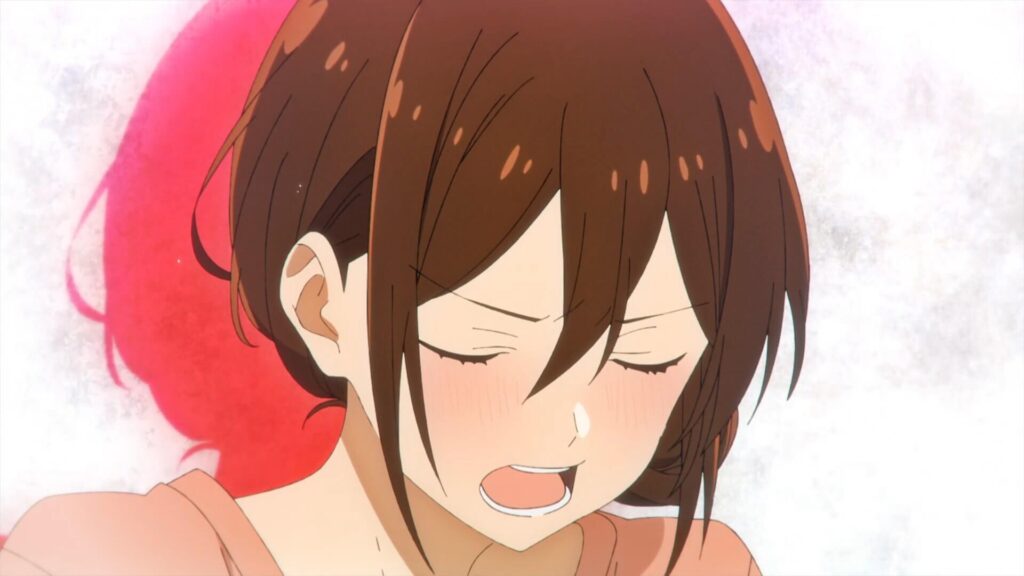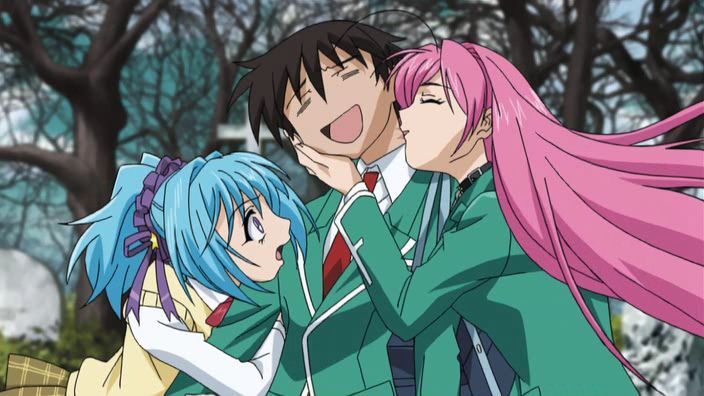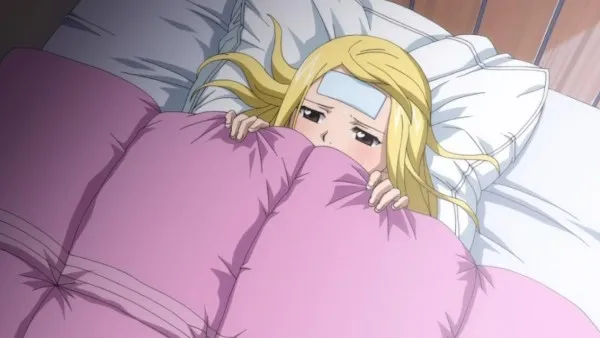
You know the scene. It starts with a sneeze or a chill, usually after being caught in the rain. Next, the character collapses into unconsciousness. Sometimes this happens in the classroom; other times it happens during some emotional event, such as a kokuhaku. The character’s friends and love interest rush to their side. They call ambulances or rush the character to the school infirmary. What could it be? A heart problem? Some other fatal illness?
How about a cold?
The cold-flu-fever episode appears in most romantic-comedy anime stories. Most rom-com anime stories follow a specific pattern of situations: the forced-together situation, the forced-apart situation, the cold episode, summer vacation, the swimsuit situation, return-to-class, and the school festival. The order sometimes varies, but most stories involve scenes that follow this template. The cold situation appears close to the forced-apart scenario. The on-again-off-again couple are in an off-phase. The cold serves as a means to show how they actually feel about each other and presents a chance for one (often the girl) to visit the other character in a different environment. In many cases, this is the first time she visited his house. This provides a chance for her to meet his family, if she hasn’t already, and confront her own deep emotions. The scene focuses more on the visiting character than the sick one. The trope often has the sick character unable to remember the visit.
During the off-again part of the cycle, the visitor is the cause of the current situation. Sometimes they are the cause for the sickness. The scene provides a shift in the visitor’s thinking, warming them toward the sick character. The scene points to how we take people for granted and how precarious life is. Of course, the cold episode happens so often the viewer knows there’s zero stakes. After a convalescence period the character is back, and so are the on-again-off-again antics. Although these antics now move toward a resolution. Whether or not the story follows the momentum to a resolution is a different matter. Many stories cope-out in the end and never resolve the question: will they ever get together? But the momentum started from the cold scene pushes toward the suggestion that, indeed, they do get together.

The cold scene, because of how it sits in the rom-com template, quickly loses its impact even if the variations can be charming. Kaguya-sama: Love is War has a funny and charming cold scene that reveals a different side to Kaguya’s character. And that is the point of the scene. These scenes serve character development rather than provide a true plot point. There’s no true tension here. Most rom-coms have little tension when you analyze them. There’s a polite harmony even amid the off-again-on-again cycle. Colds aren’t fatal because this would disrupt the harmony of the story’s characters. Fever scenes show a side of the characters they each hadn’t seen before. It can be family, vulnerability, a silly side, or anything else. At the same time, the visiting character not only learns this side but also faces emotions she wasn’t aware of within herself. She realizes her feelings and how much the sick character means to her. The old adage, absence makes the heart, plays well here. She also sees her side of the conflict. If her actions are the cause for the cold, she will awaken to how she needs to stop what she is doing before true harm happens.
Of course, there’s also a bit of a fantasy here. For rom-coms aimed at young men, a beautiful love interest arriving to take care of you while you are sick offers a version of fan-service. But this also allows men to indulge vulnerability and a softness that misconceived ideas of masculinity condemn. Men aren’t supposed to show weakness. You will see this idea appear as the sick character tries to downplay and hide how crappy he feels until he collapses from it. While the idea of a cold making someone collapse is rather extreme, the trope points to how men are socialized to ignore their own needs and keep pressing on until the body forces them to stop. The female love interest then says words I’m sure every husband has heard from his wife at some point: slow down and stop being stubborn.
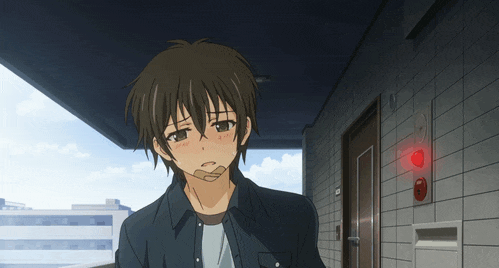
The cold trope provides a way for the love interests to meet in a more intimate setting for the first time. This template can also work for same-sex couples, but they have a different dynamic. Because the guy is out of commission, the female character feels safe, if still nervous, to be with him. She’s able to indulge her motherly side, if for a moment, while taking his measure through his room. A common gag involves looking around for porn magazines or the lack thereof. Whenever the girl takes the role of the sick character, the male character wrestles with the implications of being alone with her while she is helpless. Some characters, in the garbage stories, wrestle with leering at her. In the better stories, he frets about the social implications even though he won’t try anything. This part of the trope points to how society sees men as sex-driven. Granted, these stories deal with teens, but the fact the male character has to even worry about society thinking such a thing ought to insult men of character. Yet, the girl doesn’t worry about this despite how male rape is a reality and is under reported; some studies suggest male rape happens as often as the rape of women. “Evidence also shows that 80% of those who rape men are women.” (DiMarco, 2022). Rarely does a female anime character in this scene worry about society thinking that of her.
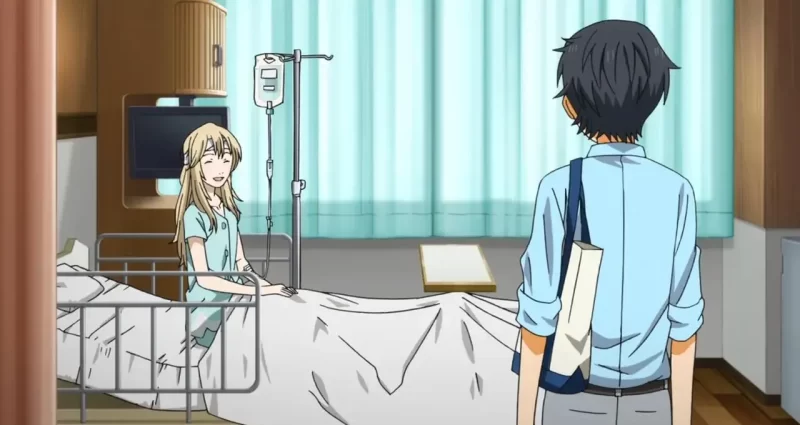
The cold scene plays a vital role in most rom-com stories. It serves as a catalyst to change the moment more toward togetherness in most causes, even if more conflict erupts because of it. The scene also points to how ideas of sexual assault–which are an undercurrent when the guy visits the sick girl–aren’t a factor when the girl visits the guy even though men likely suffer sexual assault as women do. It would be interesting to see rom-coms add more tension by making the cold scene more serious. Perhaps the character is actually dying or is otherwise hospitalized with a problem that forever alters them. Long-term COVID could even be explored through this trope. Such a change would convert the cold scene to a “door of no return”, altering how the other pieces of the rom-com template play out. However, this would break from the warm-fuzzies most rom-coms wrap themselves in, but such a ploy would up the stakes. That is, until the life-altering sickness scene becomes a part of the template. We have to keep in mind that the templates we see in modern stories were once original and new. They become cliches and templates because they worked so well when they were first introduced. Many modern viewers and readers want the same but different. They don’t want a story that is too unfamiliar. That becomes uncomfortable. This is why most rom-com anime follow a template and why most New York Bestselling novels follow genre templates. You tweak the details and characters inside the framework to make it just different enough to be interesting, but the familiarity of the templates make readers feel safe. People even get angry when you move away from the template. Don’t end a romance with the lovers separating! While an anime rom-com can exist without the sickness scene, most have it because it is an effective part of the framework.
References
DiMarco, David, et al (2021) On the Sexual Assault of Men. Sexuality & Culture, 26 465-473.

